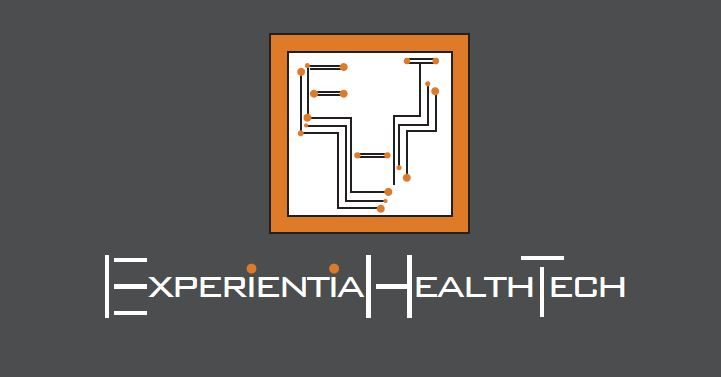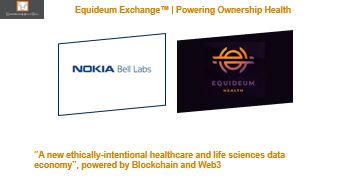Healthcare and Life Sciences (HLS) leaders have dug a lot of deep holes for themselves. Could Web3 yet prove their saviour, and diminish some of their self-inflicted and our real-world problems?
At this point in the ‘digital revolution’, it’s worth reminding ourselves of the many unresolved ‘bread and butter’ issues – taking the shine off what has been achieved. Too many remain unable or unwilling to get closer to the ‘what good looks like’ model we all keep talking about.
Pockets of pioneering HLS have over the last 7 years successfully notched up a range of use cases that exploit several of the core components of Web3, in all but name – the loose reference to it as the next evolution of the internet doesn’t do justice.
There’s a lot of hype surrounding Web3 at this point, with the wide range of accompanying definitions only adding to the confusion.
But this is far from a fad. And in my view, the HLS community is one of the verticals that can build a solid business case to embed many of its core concepts.
The Metaverse | So Near Yet So Far for HLS
The metaverse has already passed the ‘so what’ test among pioneering providers and life sciences organisations, with deployment in the field for some 7 years now.
Investment has been made across a range of hybrid novel settings: to explore; test & validate; benchmark; educate; and move beyond our legacy ‘one size fits all’ intervention model.

Yet today’s installed base is only really scratching the surface in terms of what could be delivered. Most likely is that exploration and uptake of these sub-components will continue to be incremental, while operational and clinical models continue to reconfigure, evolve, and mature. And let’s be clear, no-one is waiting for 5G to drop before they set out along this path.
The real sustainable benefit of Web3 will come from the bringing together of these ‘proven’ elements, along with others yet to be fully explored.
What Exactly is Web3
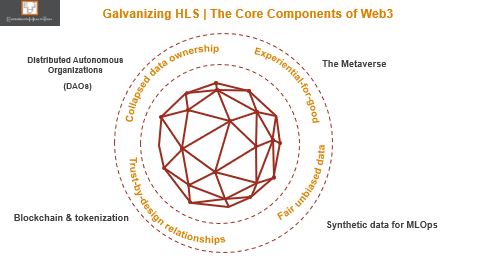
Web3 ultimately isn’t so much about the technology implemented, but the art of the possible. It provides a platform through which to pragmatically and simultaneously resolve many of today’s challenges – especially those cultural ‘brick walls’. To quote Sun Tzu from ‘The Art of War’: “Supreme excellence consists of breaking the enemy’s resistance without fighting.”
Alongside the metaverse, blockchain and tokenisation has been making inroads within pockets of HLS – although at a comparatively slower rate. For good reason however, and my view is that the grounded pragmatic examples coming through here will help to convince other cautious or sceptical peers of its validity.
But to my mind the two greatest jewels in the Web3 treasure chest are DAOs and synthetic data. Hand in glove, they offer those within the HLS community the first real opportunity to get ahead of the innovation and discovery curve, instead of chasing their tails.
DAOs are the Wrap Around to Web3’s Success
With the interoperability war raging against many of you incumbents right now, and serious efforts to get more HLS stakeholders to collaborate, while pressure mounts to redesign the patient engagement model, Decentralised Autonomous Communities (DAOs) could really strike a chord.

I view DAOs as a more formalised type of the Trusted Research Environment model that’s being actively encouraged within some of the pioneering health systems. DAOs by nature will offer greater scope to integrate a broader range of stakeholders into a community of practice: removing so many of the barriers and uncertainties on how to progress together, within tightly governed parameters. DAOs will add to rather than derail effort to collaborate, and will help to see the wood from the trees in settling clear obtainable goals.
More meaningful relationships could also be nurtured with patients, who, encouraged by the open door a DAO membership offers, would be more likely to sign up and fully participate.
All you health tech incumbents should note that you too can play a meaningful role here. Those among you whose work straddles providers, medtech, and/or life sciences will have more options to consider over the longer-term.
Access to Real World Data is Limiting | Let’s Synchronize
Nearly every conversation across HLS these days involves data – what good data looks like; where to get hold of it; how to exploit it for insight; who owns it; how biased it is.
We’re all aware of the many contexts and settings across the HLS landscape where a data strategy is not a leadership priority or capability; where good data isn’t being captured; where good data is being hoarded; where analytics skills are poor.
The more HLS matures, the more leaders realise they need good data. We’ve now reached the tipping point on fit-for-purpose data. The outstanding challenges in basic data capture and accessibility leave us no nearer to population health.
Enter synthetic data.
And yet the proven benefits from the field in creating synthetic data, if more widely understood and deployed at-scale could be a seismic catalyst for positive change across so many fronts.
Already being used in pockets of life sciences to bolster trials, it’s gaining momentum as a safe accelerant for predictive care. It’s accredited with the same statistical and business value as data collected in the field, or to supplant when real data isn’t available, or when such data is scarce, yet it carries no risk of being traced back to the real source.
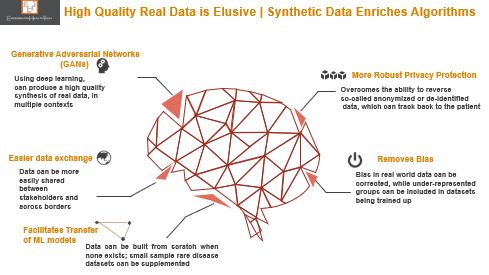
One of the most obvious and potentially far reaching use cases will be in the field of digital twins: creating synthetic (proximal) data to mimic certain characteristics of a person, and use this as a blueprint to create a generic model that can be applied in other context.
Web3 could help generate a completely new data continuum, a gift that would keep on giving, locally and internationally.
Health Tech Vendors Must Start Planning Now to Support Web3
Yes, Web3 is in its infancy, but it points to a solid opportunity for incumbent vendors and telcos to pursue beyond hyped ‘trends’. That’s why it makes sense for you to get involved in some way at this grass roots level, and identify your entry point.
I’d advise you start planning for this alongside your Business-as-Usual. Because not only will it determine some of your future customers; it will also clarify how you’ll need to upskill your teams; the new types of partnerships to invest in; the lines of business to add; new incentive programmes.
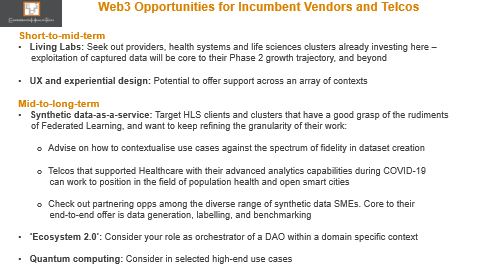
New Web3 competitor types are emerging, not necessarily familiar with HLS. Closer to home, those currently stealing a march are cloud leaders with an HLS footprint, biotechs, and the new breed of health tech bellwethers – culturally geared to operate in ‘future-ready’ mode.
But this is not a gold rush – your effort will deliver both short and intermediate wins while Web3’s infrastructure matures, and momentum builds.
There are also several weak aspects of the model that could dilute the core mission of Web3, to honour the voice of diversity – see below. In most of these areas, an answer lies in your hands.
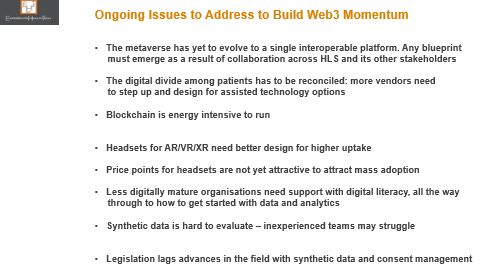
And if you’re unsure or sceptical at this stage, check out below the growing list of names coming together to form Web3- and related standards consortiums.

